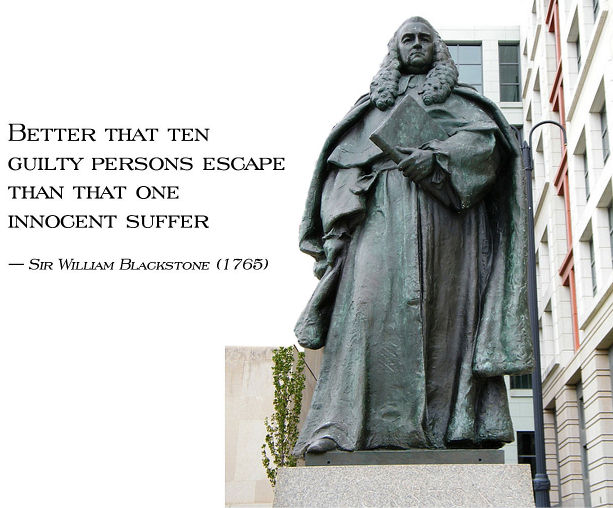|
Beyond reasonable doubt of guilt or Guilty beyond reasonable doubt
In criminal
law, Blackstone's
formulation (also known as Blackstone's
ratio or the Blackstone
ratio) is the principle that:
"It is better
that ten guilty persons escape than that one innocent suffer",
...as expressed by the English jurist William
Blackstone in his seminal work, Commentaries
on the Laws of England, published in the 1760s.
s 141 of the
Evidence Act 1995 (Cth) established that the criminal standard of proof is
as follows:
(1) In a criminal proceeding, the court is
not to find the case of the prosecution proved unless it is satisfied that it
has been proved beyond reasonable doubt.
(2) In a criminal proceeding, the court is
to find the case of a defendant proved if it is satisfied that the case has been
proved on the balance of probabilities.
At its most basic level, beyond reasonable doubt means to be certain, as Barwick
CJ observed in
Keely v Brooking (1979) 143 CLR 162; 25 ALR (at 169; 48):
“Adherence to the well understood standard of proof in the trial of criminal
offences is quite adequate to protect the individual charged summarily with
contempt of court. To be satisfied beyond all reasonable doubt is, for the
purposes of the law, to be certain.”
In
R v Standley (1996) 90 A Crim R 67 (SA CCA), the court after directing on
proof beyond reasonable doubt stated the following, “[I]f you think there is a
reasonable possibility that the accused is not guilty, then he’s entitled to be
found not guilty”.
The notion of guilty beyond a reasonable doubt has been a dearly held precept
within Australian criminal law for over 250 years. However,
Guilty beyond any doubt
provides three more recently available forms of evidence of guilt that
render the strength of the above age old adage impotent as a reason to not
execute a criminal found guilty of a vicious premeditated murder/s when the
Material
Public
Purse Prison and Prisoner Costs of incarceration and the need to provide
Justice for the Innocent Victim/s and
Community
Protect are weighed in.
Historically, the details of the ratio have varied, but the message that
government and the courts must err on the side of innocence has remained
constant. Although
Authoritarian personalities
tend to take the opposite view; Bismarck is
believed to have stated that "it
is better that ten innocent men suffer than one guilty man escape".
The
standard
that
must be met by
the
prosecution's evidence
in a criminal
prosecution:
that no
other
logical explanation
can be
derived
from
the facts
except
that
the defendant
committed
the
crime, thereby
overcoming
the
presumption that
a person is
innocent
until
proven guilty.
If the
jurors or
judge
have no doubt as
to the
defendant's
guilt, or if
their
only doubts
are
unreasonable doubts,
then
the prosecutor
has
proven the
defendant's
guilt
beyond a reasonable
doubt
and the
defendant
should be
pronounced
guilty.
The
term
connotes that
evidence
establishes a
particular
point to a
moral
certainty and
that it is
beyond
dispute
that
any reasonable
alternative is
possible. It
does
not mean
that no
doubt
exists as to the
accused's
guilt,
but
only that no
Reasonable Doubt is
possible from
the
evidence presented.
Beyond a
reasonable
doubt is
the
highest standard
of proof
that
must be met in
any
trial. In civil
litigation,
the
standard of proof
is either
proof by a
preponderance of
the
evidence or
proof by clear
and
convincing evidence.
These
are lower
burdens of
proof. A
preponderance of
the
evidence simply
means
that one
side
has more
evidence in
its
favor than
the
other, even by
the
smallest degree.
Clear and Convincing Proof is
evidence
that
establishes a high
probability
that
the fact
sought to be
proved is
true.
The main
reason
that
the high
proof
standard of reasonable
doubt is
used in
criminal
trials is
that
such proceedings
can
result in the
deprivation of a
defendant's
liberty or
even in
his or
her
death. These
outcomes
are
far more
severe
than in
civil
trials, in which
money
damages are
the
common remedy.
|
